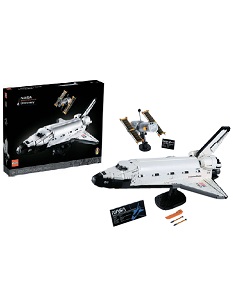Regular readers of ROOM may remember my article on “Lego’s replica space programme” [issue #24, 2020], in which I suggested “that icon of human space travel, the Space Shuttle”, as the next space-related Lego model. Little did I know it was already in the works!
In celebration of the 40th anniversary of the Shuttle’s first launch in 1981, Lego released this incredible 2354-piece puzzle for reasonably well-off adults. I say ‘puzzle’ because these ‘sets’ (as the company prefers to call them) are more 3D puzzle than construction kit, and can be challenging even when using the 320-page builder’s guide that comes in the box.
Indeed, one has to be impressed with the designers, who (no doubt after much trial and error) have produced a collection of modules that build – almost as if by magic – into a reasonable representation of the real thing. And it’s easy to become complacent about it being only a matter of following the (beautifully colourful) diagrams: for example, at one point, I blamed a missing piece for my inability to mate two complex modules when, in fact, I had put that very same piece in the wrong place!
Moreover, far from being a static lump of coloured plastic, the model has opening payload bay doors, a posable remote manipulator arm and a separate model of the Hubble Space Telescope that will fit inside the payload bay. Along with the split tail/speedbrake and moveable elevons (turn the centre engine), perhaps the most impressive design feature is the spring-loaded undercarriage which is deployed (spoiler alert) by pushing the rear-mounted body flap. The fact that Lego’s designers managed to incorporate a mechanism linking all three landing gears and the body flap, without intruding into the payload bay or otherwise compromising the structural integrity of the model, is worthy of the engineering excellence of the Space Shuttle itself.











